On the Cover: Kilimanjaro African .375 H&H
Sports Afield
(May/June 2011)
Kilimanjaro's latest masterpiece, shown on the cover of this issue, features an Exhibition Grade Bastogne Walnut stock, and Kilimanjaro's proprietary Stealth Lamination of the solid wood stock for superior stability and strength. This full custom stock is hand-carved, hand-shaped, and hand-fitted to customer specifications by Kilimanjaro's master gunsmith. The stock is mated with the barreled action using full-length bedding unique to Kilimanjaro after exact fitting of the wood to metal. Achievable only because of the stability of the Stealth Laminated wood, the full-length bedding with a precise wood-to-metal fit enable better accuracy and reduces harmonic variability.
The rifle is built on a Lilja 24-inch stainless barrel (1:12 twist; 11 degree recessed target crown) with match chambering, and Kilimanjaro's own Serengeti action made in the rough by MRC with final machining and fitting by Kilimanjaro. The Serengeti action features a jeweled bolt, full controlled-round feed, full-length Mauser claw extraction, a Winchester style three-position shroud safety, Sako-style bolt release, smooth-as-glass bolt operation, and the original Mauser C-Ring design for superior action-to-barrel mating.
The hand-carved Diamond Fleur checkering is by Mary Ann Hockenberry. The deluxe engraving package with 14kt-gold inlay is by Diane Scalese. The rifle also features specially sculpted Talley QD rings and bases, NECG iron sights, Kilimanjaro Black ceramic metal coating with color-case hardened accents, a shadow-line Monte Carlo style cog and cheek-piece, a Pachmayr Decelerator recoil pad, ebony fore-arm tip, two ebony capped cross-bolts, and an ebony ring grip cap with walnut insert.
Length of pull is 14.0 inches, trigger weight is set to 2.5 lbs., and the overall unloaded weight is approximately 9.5 lbs. The rifle comes complete with Kilimanjaro's Deluxe Delivery Package with a Pelican 1750 hard case, a Kilimanjaro embroidered soft case inset into the hard case lid, and a separate bolt/utility soft case.
Kilimanjaro extends a full lifetime guaranty to the original purchaser on all of its rifles. Regular price on this rifle is $18,795. —D.R.
Rifle Stock Design
The style of stock on your hunting rifle makes a surprising difference in how comfortable the rifle is to shoot.
Sports Afield - John Barsness
(May/June 2011)
Like many tools made by humans, the stocks of hunting rifles vary considerably both in form and decoration—though more in decoration. This isn't totally surprising. Few shooters really understand how stock shape affects a rifle's overall function, but most humans have a need for expression and approval.
This is why sixteenth-century wheel-locks made for French royalty are as complexly decorated as sixteenth-century French palaces, and why twenty-first-century American rifles vary from fine walnut with fleur-de-lis checkering to synthetics with swirls of cream and turquoise.
Even those grumpy sportsmen who firmly preach that a rifle is simply a tool often beat the snot out of their stainless-synthetic .338s, thereby gaining the approval of their equally "practical" friends and enemies. Well-beaten rifles are one of the primary fashion statements among Alaskan hunters, who sometimes add a little duct tape for contrast.
The 1950s and 1960s were the peak of the so-called "California style," popularized by Roy Weatherby, with exaggerated curves and odd angles, along with inlays of ivory, ebony, rosewood, and even colored plastics. It's probably no coincidence that this era also saw the beginning of the NASA space program, when "rocket-ship" design appeared in many areas of American life, including the tailfins on Cadillacs. One odd phenomenon is that often the most virulent present-day critics of the California style are those who like really outlandish synthetic stocks.
Some stock decorations had their origins in function. Checkering began as an aid to holding a rifle, especially when the wood became wet with rain or sweat. Eventually, however, the checkering pattern became an end in itself. The patterns became more ornate, with spear-points, fleurs-de-lis, ribbons, and fancy borders. They "wrapped" around the fore-end and grip, and the diamonds became smaller. (Tiny diamonds imply greater skill, as well as more money spent, always a consideration when showing off a rifle). Today some checkering diamonds are so small that they don't help in gripping the rifle, but such rifles probably don't go out in the rain very often anyway.
Some sources suggest that contrasting fore-end tips were originally intended to cover the end-grain of the stock, where moisture can enter the wood and warp the fore-end, causing problems with point of impact and accuracy. This was a real problem back in the day when stock finishes were primarily natural oils such as linseed and tung: Organic oil finishes look nice, but don't do much to prevent moisture from entering wood. Originally, fore-end tips were made of much denser hardwoods, such as ebony or rosewood, although ivory was sometimes used. Some modern fore-end tips are plastic, for more effective at blocking moisture, and today even ebony tips are usually attached with epoxy, itself really good at blocking moisture.
Grip caps were originally designed to prevent chipping of the sharp edges of the pistol grip, and the steel cap still works very well for that purpose, whether a full or "skeleton" cap. But extreme California stocks often had a flaring grip cap made of contrasting wood, with much sharper edges than a standard pistol grip. These often became chipped and scarred, one of the reasons the California style was criticized by more conservative shooters, who tend toward grumpy practicality even if it costs a lot.
Many shooters blame Roy Weatherby for white-line spacers between fore-end tips and grip caps, but in reality white-spacers were invented before World War II by custom gunsmith Frank Pachmayr, whose name is still on the popular Decelerator recoil pad. Pachmayr was from southern California, but he primarily made very fine, classic-style stocks out of spectacular pieces of California walnut. Some of the first white-line spacers were made of sheets of ivory as a classy contrast to ebony, but eventually plastic spacers appeared on every grade of factory rifle, which is the reason some shooters consider them cheap and tasteless today.
On European rifles, the fore-end often ended in a schnabel, a down-curved, wider tip that's normally added to a short, slim fore-end. Schnabel is German for beak, and the beak on a stock's fore-end was originally designed as an aid to shooting. The hunter grabbed the knob, or pressed his front hand firmly against it, the reason traditional German stocks were only checkered on the pistol grip. Some full-length fore-ends even had a midpoint schnabel for exactly the same purpose.
Schnabels were also quite prevalent on early American rifles, and still appear on some, such as the present Winchester Model 70 Featherweight and Remington Model 7, because so many American gunsmiths were German. (Frank Pachmayr, for instance, was the son of immigrant German gunsmith Gustav Pachmayr.) Eventually, however, schnabels became purely decorative. After World War II, fore-ends grew longer, eventually so long that some schnabels could only be reached by an NBA forward.
While many muzzleloaders and centerfire military rifles had full-length stocks, apparently their first use on sporting rifles was on the Mannlicher-Schoenauer carbines from Austria—the reason Americans call them Mannlicher stocks. German-speaking shooters call them "stutzen" stocks, for "carbine."
My friend Phil Shoemaker, the well-known Alaskan master guide and gunwriter, theorizes that Mannlicher carbines were fitted with full-length stocks so they could double as hiking staffs when hunting the small European mountain goats called gemse in German and chamois in French. Probably so, but based on experience with my own Mannlicher-Schoenauer 6.5x54 carbine, I'd also guess that the extra stock length also helped provide a little muzzle-forward balance to short, light rifles. The balance point of my 6 1/2-pound carbine is almost six inches in front of the trigger, about the same as the balance point of an average scoped sporter with a 24-inch barrel.
Most hunters, however, are more concerned with the rear end of the rifle stock, which can also vary considerably. Roy Weatherby claimed that the Monte Carlo stocks on his rifles reduced felt recoil. The comb sloped downward toward the pistol grip, so slid away from the shooter's cheekbone at the shot.
However, an opposing school of thought held that felt recoil was only reduced with a very straight buttstock that extended directly back from the grip in a straight line to the recoil pad. This allowed the rifle to push straight back into the shooter's shoulder, minimizing muzzle rise during recoil, thus protecting the shooter's cheek without the addition of a geeky-looking hump on the stock.
In reality, both ideas are correct. The big factor in whether a Monte Carlo or classic stock feels better during recoil is the body of the human shooting the rifle.
During recoil, the rear end of the buttstock functions as a fulcrum and the rest of the rifle as a lever. In sporting rifles, the line of the bore lies slightly above the shooter's shoulder, so when the rifle pushes backward, the barrel rises. If the rifle is chambered for a big-game cartridge, the comb of the stock rises into the shooter's cheekbone. This can hurt, especially if the cheekbone isn't resting firmly on the stock before the shot, thus allowing the comb to get a running start at the face. The theory behind both the Monte Carlo and classic buttstocks is that each allows the stock to slide away from the shooter's cheek.
However, felt recoil also affects the shoulder, the primary point of contact with the stock. Shoulder-slam is usually softened by a soft recoil pad, but to be really effective, the pad must make contact with as much of the shoulder as possible.
This is where the shape of the buttstock becomes critical: Humans vary considerably in the difference in height between their cheekbone and shoulder. At one extreme are people built like NFL linemen, with their heads resting almost directly on square shoulders, minimizing the difference in height between cheekbone and shoulder. This physique works very well with a straight, classic-style stock.
At the other extreme are people built like ballerinas, with long necks and sloping shoulders. If a "ballerina" picks up a classic-style rifle and firmly cheeks the comb, only the bottom tip of the recoil pad will be touching the shoulder. When the rifle recoils, this semi-sharp "toe" of the pad jabs the middle of the shoulder joint, Also, since the low toe is now the fulcrum of the rifle, the muzzle rises more during recoil, and the comb of the stock whacks the cheekbone.
In addition, a ballerina-built shooter's long neck must be bent way forward to make contact with the comb, so there's some risk that the scope will come back and whack the shooter on the eyebrow. The rifle ends up hurting the shooter in three places: the shoulder, the cheek, and the eyebrow.
Now let's reverse the situation, and have our NFL lineman shoot a rifle with a high Monte Carlo stock. Now the middle of the recoil pad is below the middle of the shoulder. When the rifle recoils, the top of the pad (the "heel") punches the shoulder joint.
It just so happens that my wife Eileen and I tend toward the ballerina and football lineman in neck and shoulder dimensions. She's only a fraction of an inch shorter than I am, so we can use rifle stocks with the same length of pull, but otherwise the most comfortable stock for each of us is vastly different.
I didn't know this when she first started hunting, soon after we got married almost thirty years ago, because back then I was one of those who firmly believed (because so many "authorities" believed it) that a straight, classic-style stock reduced felt recoil for every human. It took more than twenty years to find out that wasn't true—and to appreciate what Eileen had been going through for a quarter-century.
A few years ago she had a custom-stocked .308 Winchester made for her by Gene Gordner of Kilimanjaro Rifles. Gene knows how to fit a stock, and Eileen's rifle has a very high Monte Carlo comb, along with a recoil pad that slants forward at the toe, to precisely meet her particular right shoulder. Now Eileen doesn't suffer when she pulls the trigger on a big-game rifle.
Men and women do tend toward the NFL lineman and ballerina body types, but there's also a considerable crossover. Some women have short necks and big shoulders, and some men are, ah, willowy. So it helps to acknowledge your body type when buying a rifle. The average factory stock is designed for the average guy, who's around 5'10" tall and 170 pounds, and if you're somewhere around there the average factory stock will work fine. But if you tend toward willowy, a Weatherby stock will suit you better than any classic-style stock—and in fact Eileen finds Weatherbys to be the most comfortable factory rifles, one reason she's hunted with my Ultra Lightweight in .240 Weatherby Magnum more than I have.
Unfortunately, many so-called custom gunsmiths really aren't. They're just as convinced as I was that a straight-combed, classic-style stock is The Answer, and so they only make that kind of stock. This is true not just of walnut-carvers but many gunsmiths who build synthetic-stocked rifles. So if there's a big height difference between your cheek and shoulder, you might look for a gunsmith who knows how to really fit a rifle stock. Gene Gordner can do the job in walnut, while Texas gunsmith Charlie Sisk frequently modifies synthetic stocks to fit individual shooters.
Length of pull (LOP) is often the only stock dimension that many gunsmiths alter, but compared to the other dimensions it's really simple. The first step is not to believe the old tale that LOP can be determined by placing the butt end of a rifle in the crook of your elbow, and your finger on the trigger. This dimension has nothing to do with overall physique, and the index finger of most humans can bend pretty easily.
The industry standard rifle LOP is 13 1/2" from the center of the trigger to the middle of the recoil pad. This works pretty well for the average adult male, but most custom stock-makers modify it by 1/8" for every inch their customer varies from 5'10". Thus a 5'6" hunter should use a LOP of approximately 13 inches, and a 6'2" hunter a LOP of 14", but those are only rough guidelines. Somebody with short arms will obviously be more comfortable with a slightly shorter stock, just as somebody with very wide shoulders will be more comfortable with a slightly longer stock. The main rule, however, is that the rifle should be easy to bring to our shoulder, but no so short that our trigger-hand thumb bonks us on the nose during recoil.
Clothing also has an effect, though not as much as some people might imagine. Modern cold-weather hunting clothes are much thinner than the bulky coats our grandfathers wore. A rifle designed for use in cold weather might be more comfortable with the LOP shortened one quarter of an inch, and I did just that with my old custom .338 Winchester Magnum when it was built primarily for Montana elk hunting twenty years ago. But I have also used that rifle when hunting in warm weather in Africa, and it worked fine even with a single thin layer of cotton.
One thing to consider when shortening stocks is bolt length. A really long bolt can be difficult to manipulate when the shooter is only 5'3" and the stock has been shortened considerably. Many he-men, especially those at least 6 feet tall, consider action-length irrelevant, but it isn't to hunters of smaller stature.
The butt end of the stock also deserves mention. I am of the firm opinion that the only sane substance to put on the kicking end of a rifle is rubber or one of its modern variations. This doesn't mean that some of my rifles don't have hard buttplates, a few even made of steel, but only because those rifles are historically correct. History, however, is full of examples of insanity. It makes much more sense to put something soft on the part of a big-game rifle that punches us in the shoulder. Rubber also protects a fine walnut stock from chipping if the rifle is ever dropped. In a perfect world nobody ever drops fine walnut-stocked rifles, but accidents happen now and then.
MEDIA HIT
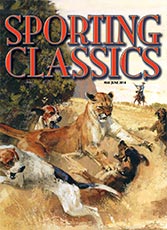
Sporting Classics
May/June 2014
"Classy to look at and a pleasure to carry, the Kilimanjaro Tigercat functions flawlessly and promises consistent accuracy, outing after outing, year after year."
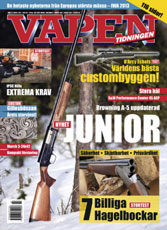
Vapentidiningen
March 2013
"My priority was to fullfil my hunting passion - to hunt down old buffalo bulls. I did, with great enthusiasm, with my new Kilimanjaro Doctari Professional Hunter rifle in .505 Gibbs..."

Sports Afield
Nov/Dec 2012
Diana Rupp
South Island Safari
A mountain-hunting adventure amid the soaring peaks of New Zealand's Southern Alps.
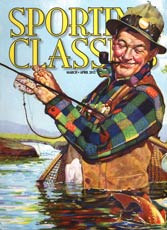
Sporting Classics
Mar/Apr 2012
Award Of Excellence
Kilimanjaro receives the Sporting Classics' Award of Excellence. "The Kilimanjaro rifle proves that old adage: There's always room at the top."
–Ron Spomer

Sports Afield
Mar/Apr 2012
John Barsness
Enough Gun
The New Doctari Rifle
from Kilimanjaro is the ideal rifle for taking on the World's biggest game.

Sporting Classics
Nov/Dec 2011
Ron Spomer
The Doctari 505 Gibbs has the handling qualities of a fine double shotgun and ballistics of a howitzer.
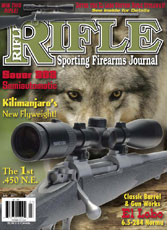
Rifle Magazine
July 2011
Ron Spomer
Kilimanjaro's Walking Rifle - The Perfect Flyweight Hunting Rig
"Okay, so it's a dream rifle. We all have them, don't we?...
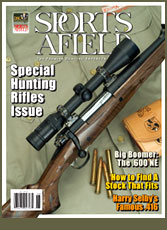
Sports Afield
May/June 2011
John Barsness
Kilimanjaro's latest masterpiece, Kilimanjaro African .375 H&H, shown on the cover of this issue, features an Exhibition Grade Bastogne Walnut stock...

Texas Sporting
November 2010
Jameson Parker
Any man with enough moxie to buy a failing custom gun company just as the economy lurches into the deepest ditch since the Great Depression is clearly a man who enjoys taking risks.

Texas Sporting
September 2010
Jameson Parker
There are few words more evocative of adventure than Kilmanjaro, the name of Africa's highest mountain,

American Rifleman Patriot Review
August 2009
Ron Spomer
Serengeti is unique among classic rifle builders because they build not just on super-fancy walnut stocks, but laminated ones as well...
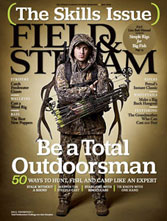
David E. Petzal,
Field & Stream Magazine, February 2006
"Serengeti… builds laminated walnut stocks that are stable yet look like natural wood…. How natural? My gun dealer, who handles many high-grade firearms...
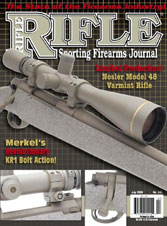
John Barsness,
Rifle Magazine,
January 2006
A couple of years ago an itch started for another rifle, thanks to Serengeti Rifles. These folks make what might be termed "cutting-edge classics," bolt-action hunting rifles...
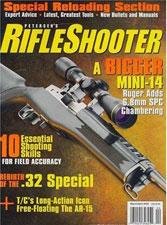
John Haviland,
Rifle Shooter Magazine,
January 2006
"Montana craftsmen don't believe that strength must be sacrificed for beauty…. The rifle is, in a word, concise. It's as light as a thin cloud, yet its stock provides a sure grip...
